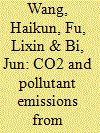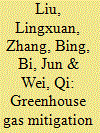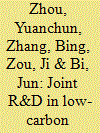|
|
|
Sort Order |
|
|
|
Items / Page
|
|
|
|
|
|
|
| Srl | Item |
| 1 |
ID:
104983


|
|
|
|
|
| Publication |
2011.
|
| Summary/Abstract |
In this paper, CO2 and pollutant emissions of PCs in China from 2000 to 2005 were calculated based on a literature review and measured data. The future trends of PC emissions were also projected under three scenarios to explore the reduction potential of possible policy measures. Estimated baseline emissions of CO, HC, NOx, PM10 and CO2 were respectively 3.16×106, 5.14×105, 3.56×105, 0.83×104 and 9.14×107 tons for China's PCs in 2005 with an uneven distribution among provinces. Under a no improvement (NI) scenario, PC emissions of CO, HC, NOx, PM10 and CO2 in 2020 are respectively estimated to be 4.5, 2.5, 2.5, 7.9 and 8.0 times that of 2005. However, emissions other than CO2 from PCs are estimated to decrease nearly 70% by 2020 compared to NI scenario mainly due to technological improvement linked to the vehicle emissions standards under a recent policy (RP) scenario. Fuel economy (FE) enhancement and the penetration of advanced propulsion/fuel systems could be co-benefit measures to control CO2 and pollutant emissions for the mid and long terms. Significant variations were found in PC emission inventories between different studies primarily due to uncertainties in activity levels and/or emission factors (EF).
|
|
|
|
|
|
|
|
|
|
|
|
|
|
|
|
| 2 |
ID:
112911


|
|
|
|
|
| Publication |
2012.
|
| Summary/Abstract |
Climate mitigation at the local level plays a highly important role in greenhouse gas (GHG) emissions mitigation. This research presents a summary of the local efforts in China's ecological industrial parks (EIPs) to assess GHG emissions and identify potential mitigation measures. Through field study and interviews in Suzhou Industrial Park (SIP), in Jiangsu Province, we conducted an energy-based GHG emissions inventory for SIP area from 2005-2010, with forecasts to 2015. The area emitted a total of 10.30 MMT CO2E in 2010. Three development strategies including business-as-usual (BAU), existing and pending regulations (EPR) and voluntary mitigating efforts (VME) were introduced to estimate the energy-related GHG emissions in 2015. The results projected that emissions will increase to 17.16 Mt in 2015 with no change in policy or practice, but 3.42 Mt of emissions are avoidable with full compliance with national and provincial energy policies (1.41 Mt), as well as local efforts (2.01 Mt). This study furthers the understanding of the potential effectiveness of carbon reduction strategies of industrial parks in China, including the development industrial symbiosis (IS) and on-site renewable energy projects.
|
|
|
|
|
|
|
|
|
|
|
|
|
|
|
|
| 3 |
ID:
114324


|
|
|
|
|
| Publication |
2012.
|
| Summary/Abstract |
Emission trading is considered to be a cost-effective environmental economic instrument for pollution control. However, the policy design of an emission trading program has a decisive impact on its performance. Allowance allocation is one of the most important policy design issues in emission trading, not only for equity but also for policy performance. In this research, an artificial market for sulfur dioxide (SO2) emission trading was constructed by applying an agent-based model. The performance of the Jiangsu SO2 emission trading market was examined under different allowance allocation methods and transaction costs. The results showed that the market efficiency of emission trading would be affected by the allocation methods when the transaction costs are positive. The auction allowance allocation method was more efficient and had the lowest total emission control costs than the other three allocation methods examined. However, the use of this method will require that power plants pay for all of their allowance, and doing so will increase the production costs of power plants. On the other hand, output-based allowance allocation is the second best method.
|
|
|
|
|
|
|
|
|
|
|
|
|
|
|
|
| 4 |
ID:
112892


|
|
|
|
|
| Publication |
2012.
|
| Summary/Abstract |
China faces the dual challenges of climate change and increased energy demand. These challenges in turn increase the demand for wind energy development. Along with rapid growth in manufacturing capacity, Chinese companies have aspired to increase their innovation capacity in order to enhance their competitiveness in the market. Joint research and development (R&D) is an attractive path for Chinese companies striving to advance their R&D capacity. This paper examines joint R&D between Chinese wind-turbine manufacturing companies and foreign design firms, assessing the performance of joint R&D activities in China using the structure-conduct-performance (SCP) framework. The study found that joint R&D has improved Chinese companies' technical capacity, human resources and financial growth. However, the effect on Chinese companies' innovation capacity is still limited because of unequal technical capacities of the two sides in collaboration, as well as their preference for augmenting profits rather than technical capacity. Current joint R&D mode is only the extension of licensing mode in wind-turbine manufacturing industry.
|
|
|
|
|
|
|
|
|
|
|
|
|
|
|
|
|
|
|
|
|